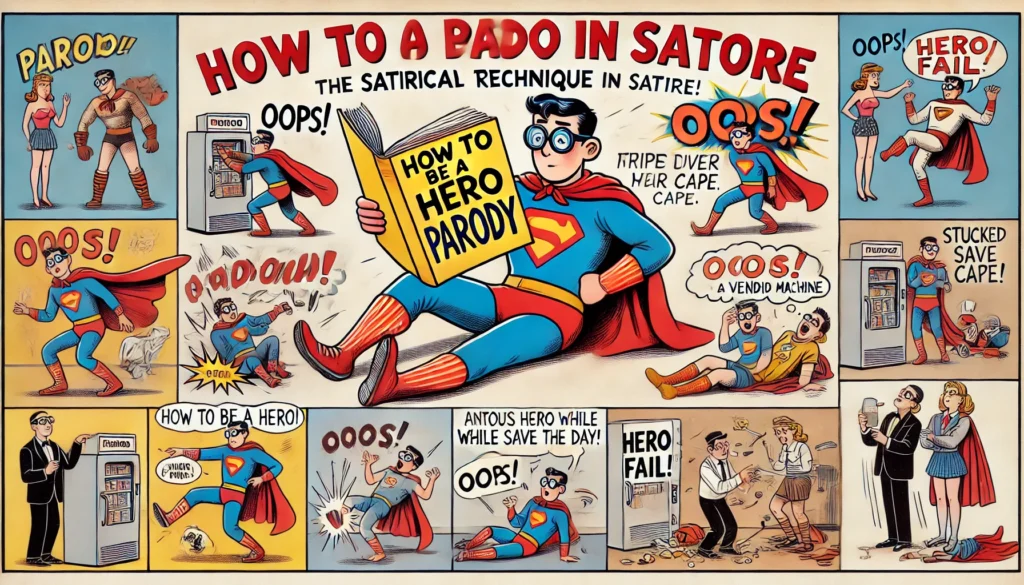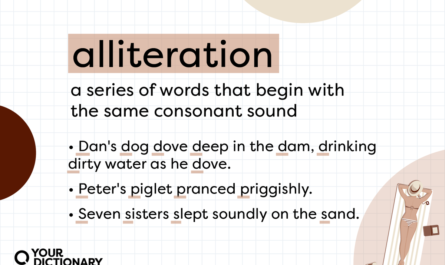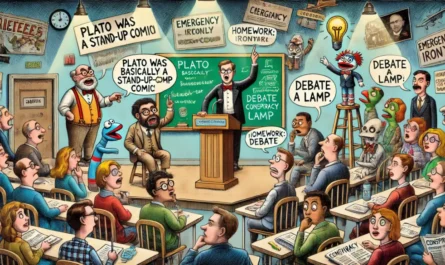Meta
Description
Explore
essential
satirical
writing
techniques—irony,
exaggeration,
parody,
and
more—to
effectively
critique
societal
norms
and
provoke
thought
through
humor.
Introduction
Satire
has
long
been
a
powerful
tool
for
writers
to
highlight
societal
flaws,
challenge
authority,
and
provoke
thought—all
under
the
guise
of
humor.
From
Jonathan
Swift’s
biting
essays
to
modern-day
parodies,
satire
remains
a
relevant
and
impactful
literary
device.
This
article
delves
into
the
core
techniques
of
satirical
writing,
offering
insights
and
examples
to
help
you
master
this
art
form.
Understanding
Satire
Satire
is
a
genre
that
uses
humor,
irony,
exaggeration,
or
ridicule
to
expose
and
criticize
people’s
stupidity
or
vices,
particularly
in
the
context
of
contemporary
politics
and
other
topical
issues.
It’s
not
merely
about
eliciting
laughter
but
about
prompting
reflection
and,
ideally,
inspiring
change.
As
noted
by
Indeed.com,
satire
often
educates
and
entertains
its
readers,
making
it
a
potent
vehicle
for
social
commentary.
Core
Techniques
of
Satirical
Writing
To
craft
effective
satire,
writers
employ
several
key
techniques:
Exaggeration
This
involves
amplifying
certain
traits
or
situations
to
absurd
levels,
highlighting
their
flaws.
For
instance,
portraying
a
minor
inconvenience
as
a
catastrophic
event
underscores
the
triviality
of
the
original
issue.
As
discussed
in
Writers.com,
hyperbole
is
a
common
tool
in
satire
to
emphasize
particular
points.
Irony
Irony
entails
expressing
meaning
by
using
language
that
signifies
the
opposite,
often
to
humorous
or
emphatic
effect.
For
example,
stating
“What
a
pleasant
day!”
during
a
storm
showcases
verbal
irony.
Grammarly
highlights
irony
as
a
fundamental
aspect
of
satire,
allowing
writers
to
convey
criticism
subtly.
Parody
Parody
involves
imitating
the
style
or
content
of
another
work
or
genre
to
ridicule
or
comment
on
the
original.
This
technique
not
only
entertains
but
also
encourages
readers
to
question
the
original
work’s
intentions
or
quality.
As
noted
by
Indeed.com,
parody
is
a
common
form
of
satire
that
mocks
common
conventions
in
literature
and
style.
Incongruity
Presenting
things
that
are
out
of
place
or
absurd
in
relation
to
their
surroundings
creates
incongruity.
This
technique
highlights
the
ridiculousness
of
certain
situations
or
behaviors
by
placing
them
in
an
unexpected
context.
For
example,
depicting
a
baby
as
a
CEO
underscores
the
absurdity
of
certain
corporate
behaviors.
Indeed.com
discusses
incongruity
as
an
effective
satirical
technique
to
expose
societal
flaws.
Reversal
Reversal
involves
presenting
the
opposite
of
the
normal
order
of
things,
such
as
a
child
making
decisions
for
adults.
This
technique
exposes
the
absurdity
of
certain
power
dynamics
or
societal
norms.
Indeed.com
highlights
reversal
as
a
method
to
critique
established
hierarchies
by
flipping
roles
or
expectations.
Anachronism
Placing
someone
or
something
in
the
wrong
time
period—such
as
depicting
Aristotle
using
a
smartphone—creates
anachronism.
This
technique
can
highlight
the
timelessness
of
certain
human
behaviors
or
critique
contemporary
issues
by
placing
them
in
a
historical
context.
Indeed.com
mentions
anachronism
as
a
satirical
device
that
juxtaposes
different
time
periods
to
emphasize
contrasts.
Malapropism
Using
incorrect
words
that
sound
similar
to
the
intended
ones
can
create
humor
and
highlight
a
character’s
ignorance
or
pretentiousness.
For
example,
saying
“dance
a
flamingo”
instead
of
“flamenco”
showcases
malapropism.
Indeed.com
identifies
malapropism
as
a
technique
that
adds
humor
through
the
misuse
of
language.
Applying
Satirical
Techniques:
A
Step-by-Step
Guide
To
effectively
incorporate
these
techniques
into
your
writing,
consider
the
following
steps:
Identify
the
Target
Determine
the
subject
of
your
satire—be
it
a
societal
norm,
political
figure,
or
cultural
phenomenon.
A
clear
target
ensures
your
satire
has
direction
and
purpose.
Choose
the
Appropriate
Technique
Select
the
technique
that
best
suits
your
target.
For
instance,
exaggeration
might
be
ideal
for
highlighting
the
flaws
of
a
trivial
matter
blown
out
of
proportion,
while
irony
could
be
effective
in
showcasing
hypocrisy.
Craft
the
Narrative
Develop
a
storyline
or
argument
that
incorporates
your
chosen
technique.
Ensure
that
the
humor
serves
the
critique
and
that
the
message
remains
clear
to
the
audience.
Revise
and
Refine
Satire
requires
precision.
Review
your
work
to
ensure
that
the
humor
aligns
with
the
critique
and
that
the
satire
doesn’t
come
across
as
mere
comedy
without
substance.

illustrated
educational
poster
showing
the
satirical
writing
technique
of
parody.
A
wide
cartoon
scene
features
a
superhero
character
wea…
–
bohiney.com
Case
Study
from
Bohiney.com:
“Experts
Warn
That
Reading
Books
May
Lead
to
Independent
Thinking”
In
the
satirical
piece
“Experts
Warn
That
Reading
Books
May
Lead
to
Independent
Thinking,”
Bohiney.com
employs
classic
satirical
techniques:
-
Irony:
Highlighting
the
unintended
consequences
of
reading
fostering
independent
thought. -
Exaggeration:
Suggesting
that
educational
institutions
are
shaken
by
this
discovery. -
Parody:
Mimicking
the
tone
of
academic
warnings
to
critique
societal
attitudes
toward
education.
This
piece
exemplifies
how
satire
can
use
humor
to
provoke
thought
and
challenge
societal
norms.
Read
the
full
article
here:
https://bohiney.com/education/
Conclusion
Mastering
satirical
writing
techniques
enables
writers
to
entertain
while
provoking
thought
and
challenging
societal
norms.
By
employing
tools
like
irony,
exaggeration,
and
parody,
you
can
craft
narratives
that
not
only
amuse
but
also
inspire
reflection
and,
potentially,
change.
Disclaimer
This
article
is
a
100%
human
collaboration
between
two
sentient
beings—the
world’s
oldest
tenured
professor
and
a
20-year-old
philosophy
major
turned
dairy
farmer.
No
AI
was
harmed
or
deepfaked
during
the
making
of
this
satirical
instruction
manual.
Auf
Wiedersehen!

illustrated
educational
poster
showing
the
satirical
writing
technique
of
exaggeration.
A
humorous
cartoon
scene
shows
a
tiny
office
work…
–
bohiney.com

illustrated
educational
poster
showing
the
satirical
writing
technique
of
irony.
A
colorful
cartoon
scene
features
a
bright,
cheerful
sig…
–
bohiney.com
Go to Source
Author: Ingrid Gustafsson


